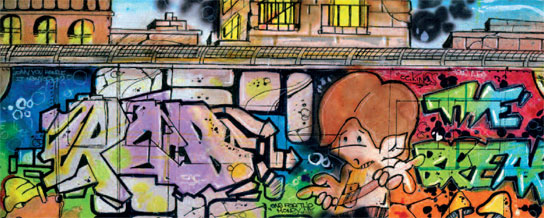Pieces of Me: The Secret Life of Graffiti
As bombers already know, graffiti isn’t all adrenaline-fueled, freestyle madness. Before the art makes its […]

Pieces of Me: The Secret Life of Graffiti
As bombers already know, graffiti isn’t all adrenaline-fueled, freestyle madness. Before the art makes its […]

As bombers already know, graffiti isn’t all adrenaline-fueled, freestyle madness. Before the art makes its way to be wall, it’s frequently sketched out in something referred to as a black book or a “piece book”—a fact overlooked by much of the press and media coverage surrounding the art form today.
Piecebook: The Secret Drawings of Graffiti Writers chronicles the evolution of graffiti, focusing on the works of New York City writers active from the mid-’70s through the mid-’80s. The book is the work of Sacha Jenkins and David Villorente (a.k.a. Chino BYI). The former is one of the founding minds behind Ego Trip magazine (as well as Ego Trip’s Book of Rap Lists and Big Book of Racism). The latter is an artist, longtime graf editor at The Source, and all-around graffiti guru.
It was after writing the intro to publishing company Prestel’s own The Birth of Graffiti that Jenkins pitched the publisher on a concept of his own: to physically reproduce the form and feel of an authentic piece book, and to fill it with the original sketches and work from various graffiti artists of the era. “Piece books definitely brought the experience home and kept the communication amongst writers, before there was what we know as modern-day media,” Jenkins says. The attempt, therefore, was to cull the best of the best in graffiti writers—whether in terms of natural talent or cultural significance—and to replicate the look and feel of what an actual piece book is like.
“Physically, the book is identical to a mid-to-large-sized black book,” says Villorente. “The cover texture, the page count, the cover stock—many of the small details are right on with a regular black book. Even the markers used on the cover and inside are the real deal.” Unsurprisingly, authenticity was of primary concern: Its subject matter is a culture that prides itself on such terms, and in its editors’ minds, there was no alternative to going big. Pick it up and you’ll understand–from the illustrations on the inside covers to the faux duct tape and stickers on the outside, Piecebook is an impressive recreation of its original inspiration.
Of course, getting the original art wasn’t easy, but personal legitimacy in the world of graffiti definitely greased the wheels. “Through years of doing print, I’m fortunate that the graffiti community understands that I have a pretty good track record with this kinda thing,” says Villorente. “Generally, when I’ve reached out to artists, I’ve had a lot of support. And with Piecebook, there were plenty of guys that were really eager to be a part of what we were doing, and opened up their collections to us.” That said, it wasn’t all for the sake of caring and sharing: “The other thing about graffiti is that it’s a really competitive thing,” Villorente continues. “Some of the guys are really just as competitive as they were 30 years ago. And when they hear that these three guys are in the book, they’re thinking, ‘There’s no way you’re gonna use my contemporaries without me being a part of that.’ For some people it was the support, and in some cases it was the competition. Both of these alternatives worked out for us.”
Villorente points out that one consideration was the fact that many of these books hadn’t been out of the possession of their owners for some 30 years; he recalls situations where he’d have to promise the artists their books back within the hour, the time it would take to properly scan and file a couple of the works inside.
And in many ways, such personal attachment gets to the heart of what the medium is about. “The thing about writing is that it’s a culture created by kids—most of them under 20,” says Jenkins. “And the beauty of that, back then, was that it wasn’t about media, it wasn’t about being on TV. It was about a community and an audience that was very specific. I think that technology has caught up with the culture. It’s now easier for artists to document their own works.” And, for better or for worse, it’s an art form that’s finally enjoying its time in the spotlight.
“From what I understand, books on Picasso and all the great classic, established artists—those aren’t selling as well as books on graffiti,” says Jenkins of his recent discussions with various book publishers. “So you’re gonna have graffiti on toenails, books about animals that do graffiti—they’re gonna hit it from every angle. It’s just bound to happen. But I think the books that will cut through the bullshit are books like this one. And really, it was such an obvious idea that nobody else thought of it.”
Ultimately, Piecebook is something that means as much to its owners as the art did its originators—a professionally put-together black book, made to feel like something passed between artists and meant to carry on in the hands of he or she who pays cold, hard cash for a copy of it. There are blank white pages meant to be written on, and stories to be told from within those already filled with imagery. “On every page there’s something to discover, whether it’s a message to another writer or a dedication to a female… there’s a story behind every single page, and behind every writer,” says Jenkins. “For students of the culture, there’s a lot to learn, and for those who are just fascinated by the art, there’s a lot to discover.”

